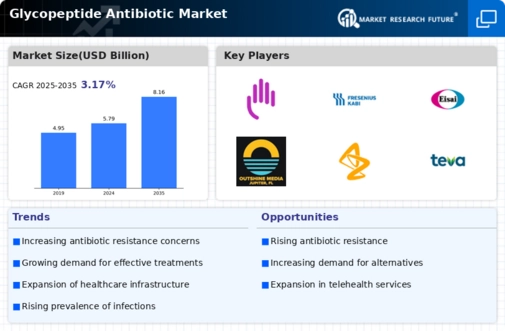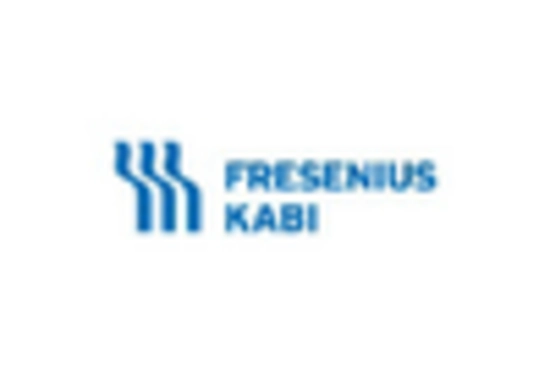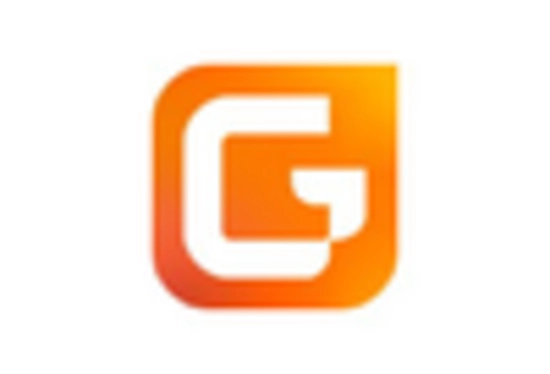Growing Demand from Emerging Markets
The Glycopeptide Antibiotic Market is witnessing a growing demand from emerging markets, where the burden of infectious diseases remains high. As healthcare infrastructure improves and access to medical services expands, there is an increasing need for effective antibiotic therapies, including glycopeptides. Market analysis indicates that regions such as Asia-Pacific and Latin America are experiencing a rise in the prevalence of bacterial infections, prompting healthcare providers to seek effective treatment options. This trend is further supported by the increasing awareness of antibiotic resistance and the need for effective management strategies. Consequently, the Glycopeptide Antibiotic Market is likely to see substantial growth in these regions, as stakeholders recognize the importance of glycopeptide antibiotics in addressing public health challenges.
Regulatory Support for Antibiotic Development
Regulatory support for antibiotic development is emerging as a crucial driver for the Glycopeptide Antibiotic Market. Governments and regulatory bodies are increasingly recognizing the urgent need to address antibiotic resistance and are implementing policies to expedite the approval process for new antibiotics. Initiatives such as the Generating Antibiotic Incentives Now (GAIN) Act in the United States aim to encourage pharmaceutical companies to invest in antibiotic research and development. This regulatory environment fosters innovation and may lead to the introduction of new glycopeptide antibiotics into the market. As a result, the Glycopeptide Antibiotic Market is likely to benefit from enhanced investment and research activities, ultimately contributing to a more robust pipeline of effective treatments for resistant infections.
Technological Advancements in Drug Development
Technological advancements in drug development are playing a pivotal role in shaping the Glycopeptide Antibiotic Market. Innovations in biotechnology and pharmacology have led to the discovery of novel glycopeptide compounds, enhancing their efficacy and safety profiles. For instance, the development of lipoglycopeptides has expanded the therapeutic options available for treating complex infections. Market data indicates that the global glycopeptide antibiotics segment is expected to witness a compound annual growth rate (CAGR) of around 5% over the next few years, driven by these advancements. Furthermore, the integration of artificial intelligence in drug discovery processes is streamlining the identification of potential candidates, thereby accelerating the time-to-market for new glycopeptide antibiotics. This technological evolution not only fosters competition within the industry but also ensures that healthcare providers have access to effective treatment options.
Rising Awareness of Healthcare-Associated Infections
The Glycopeptide Antibiotic Market is significantly influenced by the rising awareness of healthcare-associated infections (HAIs). As hospitals and healthcare facilities increasingly focus on infection control measures, the demand for effective antibiotics, particularly glycopeptides, is on the rise. Data suggests that HAIs affect millions of patients each year, leading to extended hospital stays and increased healthcare costs. In response, healthcare providers are prioritizing the use of glycopeptide antibiotics to combat these infections, especially in critical care settings. This heightened awareness is likely to drive market growth, as institutions implement stringent protocols to prevent and manage HAIs. Consequently, the Glycopeptide Antibiotic Market is poised for expansion, as stakeholders recognize the importance of effective antibiotic therapies in safeguarding patient health.
Increasing Incidence of Antibiotic-Resistant Infections
The Glycopeptide Antibiotic Market is experiencing a notable surge due to the rising incidence of antibiotic-resistant infections. As pathogens evolve and develop resistance to conventional antibiotics, healthcare providers are increasingly turning to glycopeptide antibiotics as a viable treatment option. This shift is underscored by data indicating that antibiotic resistance contributes to approximately 700,000 deaths annually, a figure projected to rise significantly if no effective measures are taken. Consequently, the demand for glycopeptide antibiotics is likely to escalate, as they are often prescribed for serious infections caused by resistant bacteria, such as MRSA. This trend not only highlights the critical role of glycopeptide antibiotics in modern medicine but also suggests a robust growth trajectory for the Glycopeptide Antibiotic Market in the coming years.

















Leave a Comment